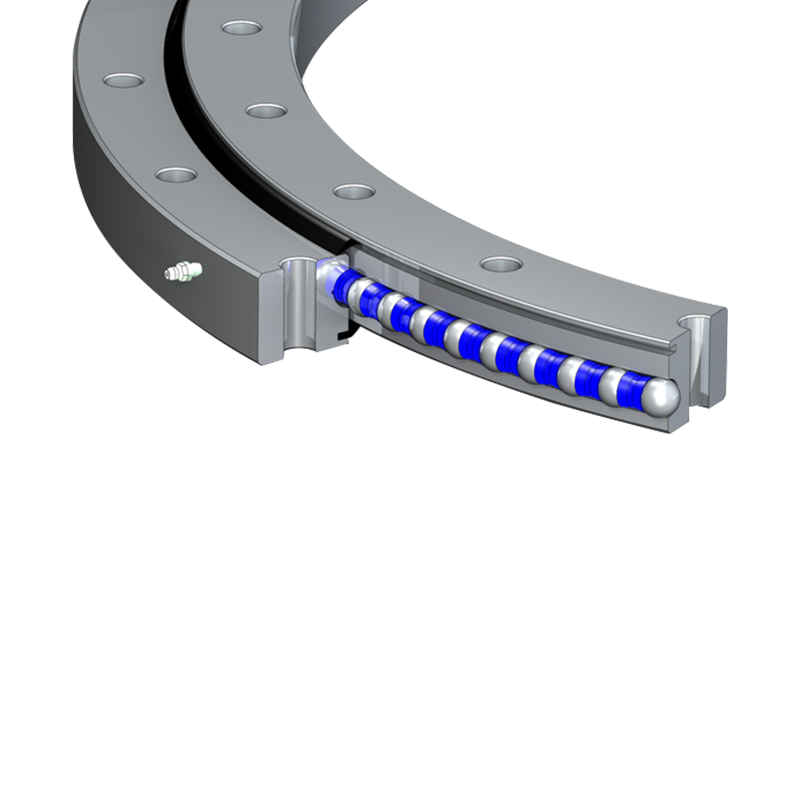How do single-row ball slewing bearings handle fluctuating loads?
 2024.12.23
2024.12.23
 Industry news
Industry news
How Single-Row Ball Slewing Bearings Handle Fluctuating Loads:
Load Distribution Across Balls: The balls in a single-row ball slewing bearing distribute the fluctuating loads across the raceways. When load fluctuations occur, the contact points between the balls and the raceways change, allowing the bearing to adjust to these variations. This means that the load is transferred dynamically between the balls during these changes, but the bearing design must ensure that the load distribution remains uniform to prevent localized stress concentrations.
Radial, Axial, and Moment Load Combination: Since these bearings can experience all three types of loads simultaneously (radial, axial, and moment), fluctuating loads often involve combined loading conditions. Single-row ball slewing bearings are generally designed to handle the interaction between axial and radial loads, but their performance under variable moment loads requires careful attention to raceway geometry and ball arrangement.
Elastic Deformation: When fluctuating loads are applied, the bearing undergoes elastic deformation (temporary changes in shape), especially if the load varies rapidly or is cyclic. A well-designed bearing minimizes deformation to ensure stable operation, but excessive fluctuations or improper preload can lead to deformation that affects precision or increases wear.
Lubrication Adjustment: Fluctuating loads can impact the lubrication layer inside the bearing. Variations in load intensity change the contact pressures and can lead to grease starvation or excessive grease. The lubricant may also experience shear thinning or pressure-induced breakdown under fluctuating loads, which can increase friction and wear.
Design Modifications to Improve Performance Under Variable Load Conditions:
Several design enhancements can help single-row ball slewing bearings handle fluctuating loads more effectively:
Optimized Preload
Purpose: Preload (the initial internal load applied to the bearing) helps maintain optimal contact between the balls and the raceways, improving load distribution and minimizing play. A properly adjusted preload allows the bearing to better absorb and handle fluctuations in load.
Modification: Increasing or optimizing the preload can help reduce the effects of fluctuating loads by ensuring more consistent ball-to-raceway contact. However, too much preload can lead to higher friction, greater wear, and reduced life.
Raceway Geometry and Ball Size
Purpose: The geometry of the raceways (e.g., radius, depth) and the size of the balls have a significant impact on the load distribution and stress absorption. An optimized geometry will distribute fluctuating loads more evenly and reduce localized stresses.
Modification: Adjusting the raceway curvature or increasing the diameter of the balls can help distribute loads more evenly across a larger surface area, improving the bearing’s performance under fluctuating loads. Profile modifications that minimize point contact and allow smoother transitions between load phases can also help absorb variable loads more efficiently.
Ball and Raceway Materials
Purpose: The choice of materials impacts how the bearing responds to fluctuating loads, particularly in terms of fatigue resistance and deformation. Materials that resist fatigue and wear are essential in variable load conditions.
Modification: Using high-performance materials such as high-carbon chromium steel, ceramic balls, or coated materials (e.g., nitride or ceramic coatings) can improve the bearing's resistance to fluctuations in load, reduce wear, and increase the lifespan of the bearing. Materials with better fatigue strength will perform better in applications where the loads fluctuate frequently.

Enhanced Lubrication Systems
Purpose: As mentioned, fluctuating loads can affect lubrication performance. Adequate lubrication is necessary to reduce friction and prevent metal-to-metal contact, especially during load fluctuations.
Modification: Sealed or shielded bearings can help maintain consistent lubrication levels and prevent contaminants from entering the bearing, even during fluctuating loads. Implementing automated lubrication systems or using synthetic lubricants can improve performance under variable load conditions by ensuring consistent lubrication under changing operational conditions.
Load Path Optimization
Purpose: The bearing’s ability to absorb dynamic loads can be influenced by how effectively the load path (the route through which forces travel) is managed. Modifying the load path can reduce the impact of load fluctuations on the bearing.
Modification: By optimizing the contact angle and number of balls, the load path can be adjusted to better distribute fluctuating forces. Angle adjustments can help balance the handling of both axial and radial loads under dynamic conditions, improving overall bearing stability.
Increased Number of Balls
Purpose: A higher number of smaller balls can improve load distribution, which helps with managing fluctuating loads. This is especially useful in applications where the loads change direction or intensity rapidly.
Modification: Adding more balls (within the limits of the bearing’s design) can increase the contact area, helping to distribute the fluctuating load more evenly. However, this may come with trade-offs in terms of speed, as more balls can create more resistance to motion.
Moment Load Capacity Design
Purpose: Fluctuating moment (tilting) loads often cause the bearing to deform more than axial or radial loads alone. Enhancing the bearing's ability to resist these moments can improve its response to variable conditions.
Modification: Increasing the contact angle slightly or altering the ball pitch can enhance the moment load resistance, particularly when the load fluctuates in a way that induces significant tilting or bending.
Advanced Sealing and Shielding Solutions
Purpose: Fluctuating loads can cause contaminants to enter the bearing or lead to lubricant loss, reducing performance.
Modification: Employing multi-lip seals, metal shields, or polymer coatings can improve the sealing effectiveness, reducing the ingress of contaminants and maintaining optimal lubrication levels despite load variations.
Use of Smart Bearings (Condition Monitoring)
Purpose: Monitoring bearing performance in real-time can help detect issues like increased friction or misalignment due to fluctuating loads.
Modification: Embedding sensors into the bearing or using IoT-based monitoring systems can detect early signs of stress, vibration, or heat buildup caused by fluctuating loads. This data can be used to adjust operation or schedule maintenance before failure occurs.












